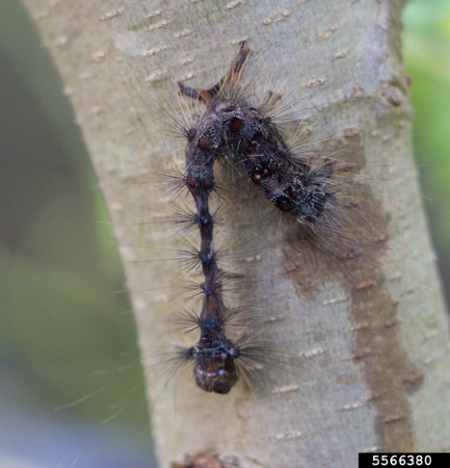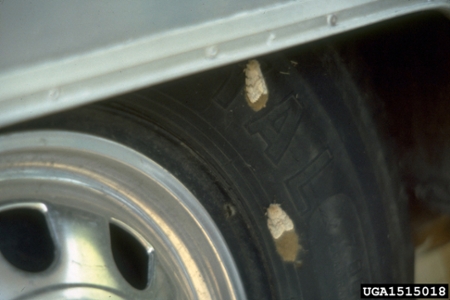Biology
Spongy Moth Life Cycle
Spongy moth caterpillars hatch in early spring, usually in mid to late April when the eastern redbuds bloom. When they first hatch, they are tiny (less than 0.25 inches) and easily go unnoticed. They spend about 40 days as caterpillars and generally reach their full size of 1.5-2 inches in mid-May to early June. In mid-June, they pupate for about 10-14 days and emerge as adults in early July. The adult moths lay their eggs from July to August on just about anything they can find. Egg masses have been found on everything from trees to house siding to car tires. Each egg mass can contain anywhere from 500 to 1,000 eggs. Spongy moths overwinter as egg masses from August to April.
Host Plants
Spongy moth caterpillars are hungry! Each caterpillar can consume a square yard of leaves during its lifetime, which lets them easily defoliate a tree during an outbreak. Spongy moth caterpillars have trees they prefer to eat but will move on to other tree species if they run out of leaves.
Spongy moth…
- Prefers oaks
- But will also eat willow, sweetgum, poplar, apple, pine, and over 500 other species of plants
- And do NOT like ash, tulip tree, black locust, black walnut.
Pathogens and Natural Enemies

Entomophaga maimaiga is a fungus that kills spongy moth caterpillars and is able to keep population levels low during rainy springs. Caterpillars infected with the fungus often appear white and dusty. If you find any caterpillars that look like this, leave them be. They will produce spores that will go on to infect more spongy moth caterpillars.

Spongy moth nucleopolyhedrovirus (LdMNPV) is a virus that only infects spongy moth. Infected caterpillars often look stretched out or limp and hang on tree trunks in an upside-down V shape. Leave these dead caterpillars in place as they help to spread the virus to other spongy moth caterpillars. The US Forest Service sometimes uses a manufactured version of this virus, Gypchek, to control spongy moth outbreaks.
Some native animals eat spongy moths. Ants, beetles, and spiders have all been observed eating spongy moth caterpillars and pupae. Some mammals like mice and shrews are also known to eat spongy moths and some studies suggest they might help keep populations low.
How They Spread

Spongy moths spread slowly on their own power, but with people’s unwitting help they can travel across the country in a few days. All life stages can be accidentally transported to a new area, but egg masses are the most likely to go unnoticed. Adult moths lay their eggs on all kinds of surfaces including trailers, car tires, and outdoor sports equipment. You can help slow their spread by inspecting your vehicles, trailers, and anything else kept outside before you travel.
Report Sightings of Spongy Moth
Great Lakes EDN app on Apple or Android app stores
Email: DEPP@dnr.in.gov
1-866 NO EXOTIC (1-866-663-9684)
